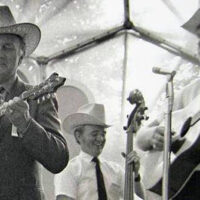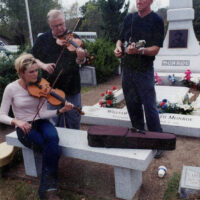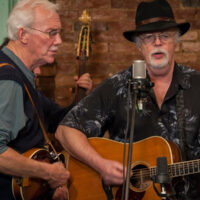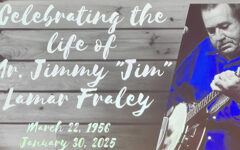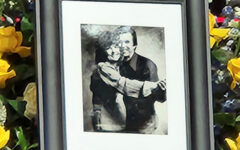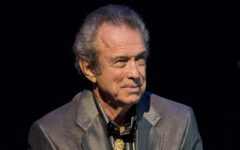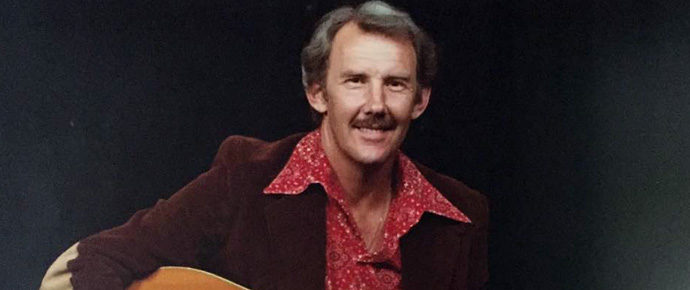
Danny Lee Jones passed away peacefully at his home in Louisville on February 3, 2017. He was 77 years old and had been battling the effects of multiple major cancers.
He was born on June 3, 1939, in Caneyville, Grayson County, Kentucky, and was a self-taught musician; a gifted player of the mandolin and the guitar.
Jones was a Blue Grass Boy, playing guitar with Bill Monroe from June to August 1971, during which time he achieved his childhood dream of playing the Grand Ole Opry.
An Army veteran, he used to be a linebacker in professional football, and later he was State Pipe Smoking Champion as well.
During the early 1960s he performed in the Grayson County Boys before going on to join Bluegrass Alliance, replacing Wayne Stewart in 1968, shortly after the band’s formation in 1967. He played mandolin and guitar and sang lead for the group, establishing his credentials in the Louisville area. He had a distinctive style and was a major influence for many bluegrass vocalists and mandolin players – including Sam Bush (with Jones in Bluegrass Alliance in 1969), Tony Rice, Ricky Skaggs and Vince Gill (a Bluegrass Alliance alumni circa 1975) – and was simultaneously a bluegrass traditionalist and an innovator of new branches of the genre.
Jones was described in 2006 as being “linked to the past, present and future of bluegrass music.”
Through the following 20 years he played with other various groups including the Bluegrass Generation, The Goins Brothers (circa 1980-1985) and more.
During this era, Danny Jones is featured on albums by the Bluegrass Generation, Carolina in the Pines (the Zeus label, 1976), the Goins Brothers At Their Best (1981) and Sweet Sunny South (1985), both on the Old Homestead label.
His talents made him a world traveler who performed in Europe twice and Australia (with Lonnie Hoppers, Joe Isaacs and Stacey York, for the Harrietville Festival).
Jones, as a member of Bluegrass Alliance, participated in the recording of two American Heritage LPs The Bluegrass Alliance (AH401-21 S) and Newgrass (AH10-30 S).
Bass player Doug Hutchens was also a Blue Grass Boy during the summer of 1971 ….
“Danny was a mainstay of the local Louisville bluegrass music scene and was retired from UPS as a long-haul trucker. He fought a brief but heroic battle with cancer and has now gone on to be with the Lord.
Danny was an extraordinary singer and musician and played through the years with Art Stamper, Melvin Goins, Joe Isaacs, the Cumberland Highlanders, Butch Robins, Jim Smoak, and many more. He was an original member of the legendary Bluegrass Alliance and played guitar and sang with Bill Monroe as a Blue Grass Boy.”
Dan Crary, “Big Dan” to distinguish the two of them in the Bluegrass Alliance, remembers his namesake fondly …..
“It was my privilege to work with Danny Jones in the Bluegrass Alliance band in 1968-1970. After the original Bluegrass Alliance lead singer left us, we invited Danny to join us in 1968. It was our good luck that he was available, and from the moment of our first rehearsal it was clear that he would be a powerful presence.
Danny started out by just looking impressive: he was about 6’4” (dwarfed the mandolin he played), movie-star handsome and dignified-looking, and carried himself like a dancer. His voice was baritone-smooth and his range was wide enough that he could sing any song or any high lead or low harmony we needed. Danny’s tone was rich, and he was one of those singers who could infallibly find the center of the note, every note, every time. He was a great pal and partner. Funny, smart, good conversationalist, very Kentucky, and an outrageously good singer; ‘Some guys got it all…’ as the saying goes.
One odd thing you can see in the old pictures: when we made a trio, Danny on the left at about 6’-4”, me in the middle at 6’-2”, and Lonnie Peerce on the right at about 5’-10”, we looked like we were standing on a Swiss mountainside. I guess we should have stood on the other side.
Happily, I had a telephone conversation with Danny just a few days ago, in late January. He told me a little about his illness and said he hoped that we would all meet again and play music on the other side. And we reminisced about our old band and the challenges we faced, and agreed that we made some good music and a little bluegrass music history. Then I thanked him for his influence on me: Danny was always the most ‘pro’ member of the band, while I was a comparative novice. I learned a lot about musicianship and performing from Danny. I guess I had never before thanked him for it outright, because he seemed a little surprised, and then he said, ‘Dan, that’s better than money.’
That was a very Danny-esque comment: sorta’ country, a little guy-talk macho, makes you laugh, paints a picture, and you won’t ever forget it. Just like the guy himself.
Godspeed, Danny… knowing you was better than money.”

